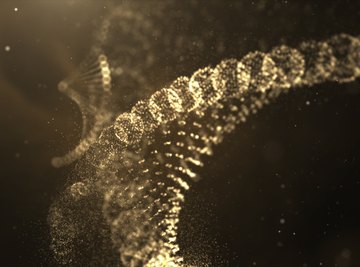
Macromolecules — Large structures composed of atoms and smaller molecular structures — play important and sometimes vital roles in creating and sustaining life. While there are many types of macromolecules, those that are fundamental to the existence of life — called biopolymer macromolecules — can be organized into four categories: proteins, nucleic acids, carbohydrates, and lipids. That said, macromolecules can be found plastics, rubber, and diamonds.
Proteins: Keep the Body Running
Proteins, like all macromolecules, form from smaller units that combine and connect together to form one larger molecule. Amino acids — which are smaller, simpler molecules — connect end-to-end to form proteins. Twenty-one different amino acids are essential to all life — there are many different combinations that can form from this set. As such, there are many different possible proteins — this varies depending on the number of sets of amino acids in a protein — each with its own particular function, ranging from attacking antigens in the blood, to regulating metabolism, to digesting particles of food. Proteins are involved in most life processes.
Nucleic Acids: Blueprints for Life
Nucleic acids — DNA and RNA — contain and describe the genetic code in life. As macromolecules, nucleic acids serve as a detailed instruction manual for the development of the body and the workings of each cell. Nucleic acids form of the sugar 2-deoxyribose, a phosphate group, and one of four base molecules. Different combinations of the four base molecules along the DNA chain encode for certain amino acids, which eventually connect together to form proteins. While DNA contains the raw genetic information for life, RNA passes messages between DNA and the cell.
Carbohydrates: Chemical Energy
Found in many energy-providing foods, carbohydrates help the nervous system, muscles, and body in general function. A group of polymers, they contain nothing but carbon, hydrogen, and oxygen. Human bodies break down carbohydrates into their base components, which it then uses to fuel cells and maintain body processes. Plants use carbohydrates, particularly cellulose, to protect their cells and to grow larger. The list of carbohydrates is extensive and includes all sugars and starches.
Lipids: Long-term Energy
While carbohydrates supply immediate energy for the body, lipids — a class of macromolecule — provide long-term energy storage. Lipids, more commonly known as fats, appear in many foods. There are dozens of lipids, many of which are important for living things. Lipids form the protective membranes around cells, and deliver essential vitamins — to name just a few of their functions. The body stores lipids as reserves of fat, but the reserves will be depleted over time as cells use the stored energy.
References
About the Author
Mary Freeman is a freelance writer. She has held several editorial positions at the print publication, "The Otter Realm." She traveled throughout Europe, which ultimately resulted in an impromptu move to London, where she stayed for eight months. This life experience inspired her to pursue travel writing. Freeman received a degree in human communication from California State University.
